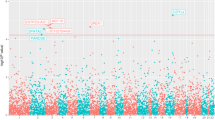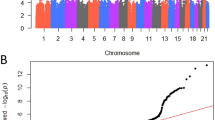Abstract
Background:
Vitamin D-deactivating enzyme CYP24A1 had controversial effects on prostate cancer risk; the genetic study also showed the controversial results. Therefore, we identified the relationships between polymorphisms in CYP24A1 and prostate cancer in a Korean cohort.
Methods:
We evaluated the association between 21 single-nucleotide polymorphisms (SNPs) in the CYP24A1 and prostate cancer in Korean men (272 prostate cancers and 173 controls). BPH patients with high PSA or abnormal digital rectal examination who underwent negative prostate biopsy were enrolled in the control group. Twenty-one SNPs in the CYP24A1 were selected from the International HapMap database and the NCBI database with calculation of minor allele frequency and linkage disequilibrium, preferably including the SNPs that were nonsynonymous and located within exons. We also investigated the association between 21 SNPs in the CYP24A1 gene and known clinical characteristics, such as the PSA level, clinical stage, pathological stage and Gleason score.
Results:
The statistical analysis suggested that five CYP24A1 sequence variants (rs2248461—odds ratio (OR): 0.63, rs2248359—OR: 0.65, rs6022999—OR: 0.65, rs2585428—OR: 0.46, rs4809959—OR: 0.52) had a significant association with prostate cancer risk after multiple comparisons by a method of false discovery rate. Logistic analyses of the CYP24A1 polymorphisms with several prostate cancer-related factors showed that several SNPs were significant: four SNPs to PSA level, three to clinical stage, two to pathological stage and two SNPs to the Gleason score.
Conclusions:
The results of this study suggest that some CYP24A1 gene polymorphisms might be associated with the risk of prostate cancer in Korean men. Five CYP24A1 sequence variants showed the significance to predict prostate cancer, and several SNPs of CYP24A1 gene had an important finding to predict prostate cancer-related factors. However, these results should be validated in future large-scale studies.
This is a preview of subscription content, access via your institution
Access options
Subscribe to this journal
Receive 4 print issues and online access
$259.00 per year
only $64.75 per issue
Buy this article
- Purchase on Springer Link
- Instant access to full article PDF
Prices may be subject to local taxes which are calculated during checkout

Similar content being viewed by others
References
Jemal A, Siegel R, Xu J, Ward E . Cancer statistics, 2010. CA Cancer J Clin 2010; 60: 277–300.
Park SK, Sakoda LC, Kang D, Chokkalingam AP, Lee E, Shin HR et al. Rising prostate cancer rates in South Korea. Prostate 2006; 66: 1285–1291.
Chan JM, Holick CN, Leitzmann MF, Rimm EB, Willett WC, Stampfer MJ et al. Diet after diagnosis and the risk of prostate cancer progression, recurrence, and death (United States). Cancer Causes Control 2006; 17: 199–208.
Chen L, Davey Smith G, Evans DM, Cox A, Lawlor DA, Donovan J et al. Genetic variants in the vitamin D receptor are associated with advanced prostate cancer at diagnosis: findings from the prostate testing for cancer and treatment study and a systematic review. Cancer Epidemiol Biomarkers Prev 2009; 18: 2874–2881.
Schumacher FR, Berndt SI, Siddiq A, Jacobs KB, Wang Z, Lindstrom S et al. Genome-wide association study identifies new prostate cancer susceptibility loci. Hum Mol Genet 2011; 20: 3867–3875.
Eeles RA, Olama AA, Benlloch S, Saunders EJ, Leongamornlert DA, Tymrakiewicz M et al. Identification of 23 new prostate cancer susceptibility loci using the iCOGS custom genotyping array. Nat Genet 2013; 45: 385–391.
Mikhak B, Hunter DJ, Spiegelman D, Platz EA, Hollis BW, Giovannucci E . Plasma 1,25-dihydroxy- and 25-hydroxyvitamin D and subsequent risk of prostate cancer. Cancer Causes Control 2004; 15: 255–265.
Li H, Stampfer MJ, Hollis JB, Mucci LA, Gaziano JM, Hunter D et al. A prospective study of plasma vitamin D metabolites, vitamin D receptor polymorphisms, and prostate cancer. PLoS Med 2007; 4: e103.
Mikhak B, Hunter DJ, Spiegelman D, Platz EA, Hollis BW, Giovannucci E . Vitamin D receptor (VDR) gene polymorphisms and haplotypes, interactions with plasma 25-hydroxyvitamin D and 1,25-dihydroxyvitamin D, and prostate cancer risk. Prostate 2007; 67: 911–923.
Ahonen MH, Zhuang YH, Aine R, Ylikomi T, Tuohimaa P . Androgen receptor and vitamin D receptor in human ovarian cancer: growth stimulation and inhibition by ligands. Int J Cancer 2000; 86: 40–46.
Ahn J, Albanes D, Berndt SI, Peters U, Chatterjee N, Freedman ND et al. Vitamin D-related genes, serum vitamin D concentrations and prostate cancer risk. Carcinogenesis 2009; 30: 769–776.
Beuten J, Gelfond JA, Franke JL, Weldon KS, Crandall AC, Johnson-Pais TL et al. Single and multigenic analysis of the association between variants in 12 steroid hormone metabolism genes and risk of prostate cancer. Cancer Epidemiol Biomarkers Prev 2009; 18: 1869–1880.
Holick CN, Stanford JL, Kwon EM, Ostrander EA, Nejentsev S, Peters U . Comprehensive association analysis of the vitamin D pathway genes, VDR, CYP27B1, and CYP24A1, in prostate cancer. Cancer Epidemiol Biomarkers Prev 2007; 16: 1990–1999.
Harris SS, Dawson-Hughes B . Seasonal changes in plasma 25-hydroxyvitamin D concentrations of young American black and white women. Am J Clin Nutr 1998; 67: 1232–1236.
Harris SS, Soteriades E, Coolidge JA, Mudgal S, Dawson-Hughes B . Vitamin D insufficiency and hyperparathyroidism in a low income, multiracial, elderly population. J Clin Endocrinol Metab 2000; 85: 4125–4130.
Zadshir A, Tareen N, Pan D, Norris K, Martins D . The prevalence of hypovitaminosis D among US adults: data from the NHANES III. Ethn Dis 2005; 15: S5–97-101.
Song SY, Kim SR, Ahn G, Choi HY . Pathologic characteristics of prostatic adenocarcinomas: a mapping analysis of Korean patients. Prostate Cancer Prostatic Dis 2003; 6: 143–147.
Oliphant A, Barker DL, Stuelpnagel JR, Chee MS . BeadArray technology: enabling an accurate, cost-effective approach to high-throughput genotyping. Biotechniques 2002; Suppl: 56-8: 60–61.
Morris JA, Gardner MJ . Calculating confidence intervals for relative risks (odds ratios) and standardised ratios and rates. Br Med J (Clin Res Ed) 1988; 296: 1313–1316.
Lewis CM . Genetic association studies: design, analysis and interpretation. Brief Bioinform. 2002; 3: 146–153.
Hedrick PW . Gametic disequilibrium measures: proceed with caution. Genetics 1987; 117: 331–341.
Stephens M, Smith NJ, Donnelly P . A new statistical method for haplotype reconstruction from population data. Am J Hum Genet 2001; 68: 978–989.
Nyholt DR . A simple correction for multiple testing for single-nucleotide polymorphisms in linkage disequilibrium with each other. Am J Hum Genet 2004; 74: 765–769.
Benjamini Y, Drai D, Elmer G, Kafkafi N, Golani I . Controlling the false discovery rate in behavior genetics research. Behav Brain Res 2001; 125: 279–284.
Leman ES, DeMiguel F, Gao AC, Getzenberg RH . Regulation of androgen and vitamin D receptors by 1,25-dihydroxyvitamin D3 in human prostate epithelial and stromal cells. J Urol 2003; 170: 235–240.
Omdahl JL, Morris HA, May BK . Hydroxylase enzymes of the vitamin D pathway: expression, function, and regulation. Annu Rev Nutr. 2002; 22: 139–166.
Nomura AM, Stemmermann GN, Lee J, Kolonel LN, Chen TC, Turner A et al. Serum vitamin D metabolite levels and the subsequent development of prostate cancer (Hawaii, United States). Cancer Causes Control 1998; 9: 425–432.
Mondul AM, Shui IM, Yu K, Travis RC, Stevens VL, Campa D et al. Genetic variation in the vitamin D pathway in relation to risk of prostate cancer—results from the breast and prostate cancer cohort consortium. Cancer Epidemiol Biomarkers Prev 2013; 22: 688–696.
Schwartz GG, Hulka BS . Is vitamin D deficiency a risk factor for prostate cancer? (Hypothesis). Anticancer Res 1990; 10: 1307–1311.
Nejentsev S, Godfrey L, Snook H, Rance H, Nutland S, Walker NM et al. Comparative high-resolution analysis of linkage disequilibrium and tag single nucleotide polymorphisms between populations in the vitamin D receptor gene. Hum Mol Genet 2004; 13: 1633–1639.
Feskanich D, Hunter DJ, Willett WC, Hankinson SE, Hollis BW, Hough HL et al. Vitamin D receptor genotype and the risk of bone fractures in women. Epidemiology 1998; 9: 535–539.
Acknowledgements
This work was supported by grant no. 03-2010-012 from the SNUBH Research Fund, grant of the Korea Healthcare Technology R&D Project, Ministry of Health, Welfare & Family Affairs the Republic of Korea (A085138) and supported by Basic Science Research Program through the National Research Foundation of Korea (NRF) funded by the Ministry of Education, Science and Technology (2012R1A12006392).
Author information
Authors and Affiliations
Corresponding authors
Ethics declarations
Competing interests
The authors declare no conflict of interest.
Rights and permissions
About this article
Cite this article
Oh, J., Byun, SS., Lee, S. et al. Genetic variants in the CYP24A1 gene are associated with prostate cancer risk and aggressiveness in a Korean study population. Prostate Cancer Prostatic Dis 17, 149–156 (2014). https://doi.org/10.1038/pcan.2014.1
Received:
Revised:
Accepted:
Published:
Issue Date:
DOI: https://doi.org/10.1038/pcan.2014.1
Keywords
This article is cited by
-
Genetic polymorphisms of CYP24A1 gene and cancer susceptibility: a meta-analysis including 40640 subjects
World Journal of Surgical Oncology (2023)
-
Association of CYP24A1 with survival and drug resistance in clinical cancer patients: a meta-analysis
BMC Cancer (2022)
-
Effects of CYP24A1 polymorphisms on premature ejaculation: a case–control study
Journal of Genetics (2022)
-
The synergistic effect between adult weight changes and CYP24A1 polymorphisms is associated with pre- and postmenopausal breast cancer risk
Breast Cancer Research and Treatment (2020)
-
Role of CYP24A1, VDR and GC gene polymorphisms on deferasirox pharmacokinetics and clinical outcomes
The Pharmacogenomics Journal (2018)



